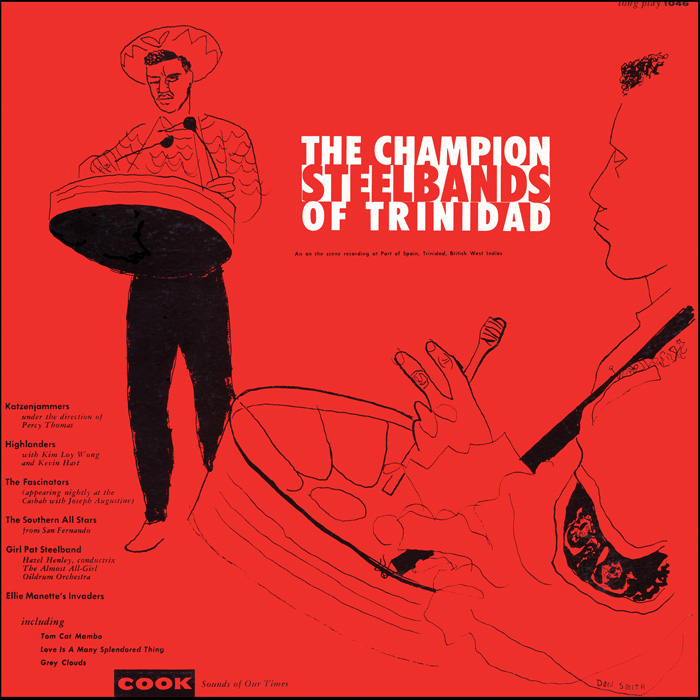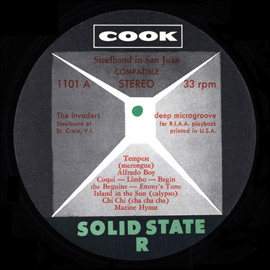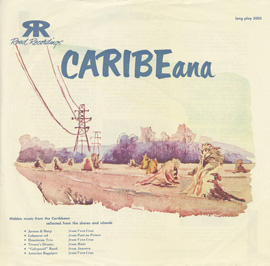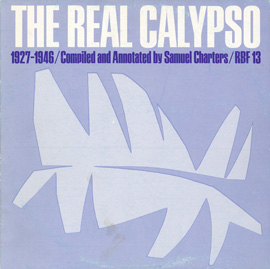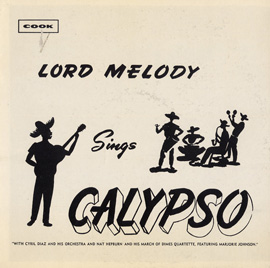Summary
Through photos, recordings, videos, and playing instruments, students will explore the steel band tradition of Trinidad and Tobago. In the first two segments, they will learn and demonstrate understanding of the basic aspects of steel band music, culture, and history. In the third segment, students will play in this style on their own string instruments.
Suggested Grade Levels: 6-8, 9-12
Country: Trinidad & Tobago
Region: Caribbean
Culture Group: Trinidadian
Genre: Steel bands
Instruments: Steel Pan, Percussion
Language: English
Co-Curricular Areas: Social Studies
National Standards: 2, 5, 6, 7, 9
Prerequisites: For Lesson Segment 2, advanced middle school-level skill on a stringed instrument, standard notational literacy
Objectives:
- Identify (by their sound) the typical instruments in a steel pan ensemble: steel pans (as a general instrument family), irons and other percussion, scraper or shaker
- Play a typical shaker rhythm along with steel band music, as well as recognize and perform several other rhythms and a melody
- Understand the basics of the history and origins of steel band music in Trinidad
- Describe features of a steel pan performance (other than just the music)
- Identify typical steel band instruments by sight
- Perform the song “PP Samba” in the steel band style
Material:
- “Top Cat Mambo” by The Invaders from Champion Steel bands of Trinidad (Cat. #COOK01046)
- “PP Samba” by the Southern All-Stars from Champion Steelbands of Trinidad (Cat. #COOK01046)
- Carnival Music in Trinidad by Shannon Dudley and accompanying CD (ML3486.T7 D83 2004)
- Photos of steel pans, maracas, and bells (Could be from Carnival Music in Trinidad or from an Internet search)
- Egg shakers or any kind of maraca-like instruments
- “Panorama ’98 the National Steelband Finals,” VHS 786.92097 P1962, available at public or school libraries; you could also used videos of this competition from other years, or other videos of steel bands, depending on what is available
- Orchestra Instruments
- Sheet music for “PP Samba”
- Shakers, Bongos
Lesson Segments:
- Listening to Steel Band Music (National Standards 2, 6)
- Trinidadian Steelband Culture (National Standards 6, 7, 9)
- Playing Steelband-style Music! (National Standards 2, 5)
1. Listening to Steel Band Music
- Listen to “Top Cat Mambo.” Ask students to listen for instruments that are familiar and unfamiliar. Do any sound like instruments they hear often? How many different instruments are there? Show pictures of the following instruments:
- Steel pans (Show different sizes: tenors, seconds, cellos, basses)
- Shakers/Maracas
- Bell/Cowbell
- Pass out shakers and teach students the simple pattern. (Shaker goes up/down/up/down, in quarter notes.) Listen to Top Cat Mambo again and invite them to play along. (Large groups can have small groups of students taking turns with shakers.)
- Listen to Track 14 from Carnival Music in Trinidad, “Back Line.” In this recording, all the instruments layer in, starting with the bass pans. (See p. 69 of book for further reference; this recording is a demonstration of how parts fit together, not a complete song.)
- 0:00 Conga drums (4 bars)
- 0:13 Bass pans (8 bars)
- 0: 33 Double seconds enter, strumming chords on off beats (8 bars)
- 0:54 Tenor pan enters with melody (8 bars)
- 1:14 Double Tenors enter, doubling melody (8 bars)
- 1:34 Cellos enter, playing strumming pattern (8 bars)
- 1:54 Entire ensemble plays it again together
- During the first listening, ask students to raise their hand when they hear a new instrument added. Afterwards, ask:
- Were the instruments added in any order? (Generally, lowest to highest, except for the cello, which is higher than the lowest voice.)
- Do you remember what rhythm the conga played? The bass? Which instruments had more complicated rhythms? (The high instruments; the tenor and double tenors with melody.)
- For the next listening, create three groups of students and assign them instruments to “play” along with in the recording.
- “Conga players” can tap the rhythm on their laps
- “Bass players” can clap or pat the quarter notes
- “Tenor players” can sing the melody (on “la,” or any way they choose)
- Each group should enter with their instrument on the recording. Repeat at least three times so each group “plays each instrument.” Depending on ability level, they may be able to clap or tap the double seconds’ off beats. (The cello strumming is difficult to hear.)
- Invite them to listen to track 14 on this CD. This is the actual song “Back Line.” Can they still hear the parts they just played? Can they tap or sing along? (The section they played along with begins at 0:17.)
Assessment:
Check if each student can successfully maintain both the shaker rhythm in “Top Cat Mambo” and the rhythm of each instrument in “Back Line.” It may help to divide students into smaller groups to “perform” this, so that they are more responsible for their own part.
2. Trinidadian Steelband Culture
- Watch two or three minutes of Carib Tokyo’s performance at Panorama ‘98. (Although both genders and many ages are represented in the entire clip, consider starting around 26:00.) Ask students to think about these questions as they watch:
- Do you find it exciting? Why?
- What do you notice about the performers? (Gender, age, attitude, movements, clothing, anything interesting.)
- Other general impressions?
- After watching, invite students to share impressions with the class; share some background history with the class, which could include some of the information attached: (This is only a basic overview, much more can be found in Carnival Music in Trinidad)
Assessment: Quiz (attached).
3. Playing Steelband-Style Music!
- Listen to “PP Samba.” Ask students to listen for which instruments they hear.
- Identify the 8-bar A, B, and C sections (and when they repeat), as well as the more complicated D section.
- Rehearse and play the arranged version of “PP Samba.”
Notes:
- Articulations and dynamics have been left out purposely so that the group has to listen carefully to the recording and decide with the help of their teacher how to best perform the music.
- The percussion parts are optional and could be played by a percussionist or, if necessary, a string player with strong rhythm skills
- The Cello I/II and Bass I/II are simply to make the song more interesting and less repetitive for the lower voices. (Both are to be played; one is not easier than the other.) This could be divided by stand or by person.
- The A section is arranged with the string bass playing the bass part, violins playing the tenor part etc. After this, the harmony and melody parts are distributed in a less traditional, but more equal and fun way.
- Optional: students might want to memorize the piece, wear bright colors for a performance, stand (except cellos) while playing, or add other elements to make the performance more similar to that of a steel band.
Assessment:
Each student can successfully play their part to PP Samba with consistent tempo, rhythm, and appropriate articulation as determined by the group.
History
- The steel drum is the national instrument of Trinidad and Tobago, and many people there feel that it is a symbol of their country as well as an important part of their identity.
- Steel pans were invented around 1940 by young people from poor neighborhoods who found a way to shape metal oil cans into instruments with distinct pitches. When steelband music was first played, it was resented by the upper class as noisy and representative of the violence unrest they associated with the lower class.
- Steelbands eventually became more widely accepted and many schools started steelbands (much as we have band and orchestra in our schools.) They became very popular in parades and carnival performances that included dancers and elaborate costumes. They also played at large parties called fêtes where guests would dance and socialize.
- Every year in Trinidad there are huge steelband competitions, often held in sports stadiums. Panorama, the one in the video, is the most important one of these.
The Music
- Steelbands play many different genres of music, including calypso, arrangements of Western European art music, pop music, film music, and a variety of Latin American music.
- Therefore, steelbands play many genres of music, but all in the steelband style.
- Steelbands are comprised of four sizes of steel pans. Beginning with the smallest and also highest, they are:
- Tenors
- Seconds (or Double Seconds)
- Cellos (or Guitars)
- Basses
The steel band also includes a percussion section, called the engine room, which can include:
- Drumset
- Congas
- Metal scrapers
- Shakers or maracas
- Pieces of iron hit with other pieces of metal
- Cowbells or other bells
Watch another clip of Panorama and pause it at various times to ask students to identify various instruments. Consider watching the first part of Phase II Pan Groove’s performance, beginning at 32:40. (Other clips would work as well, but this includes footage of the “engine room.”)


